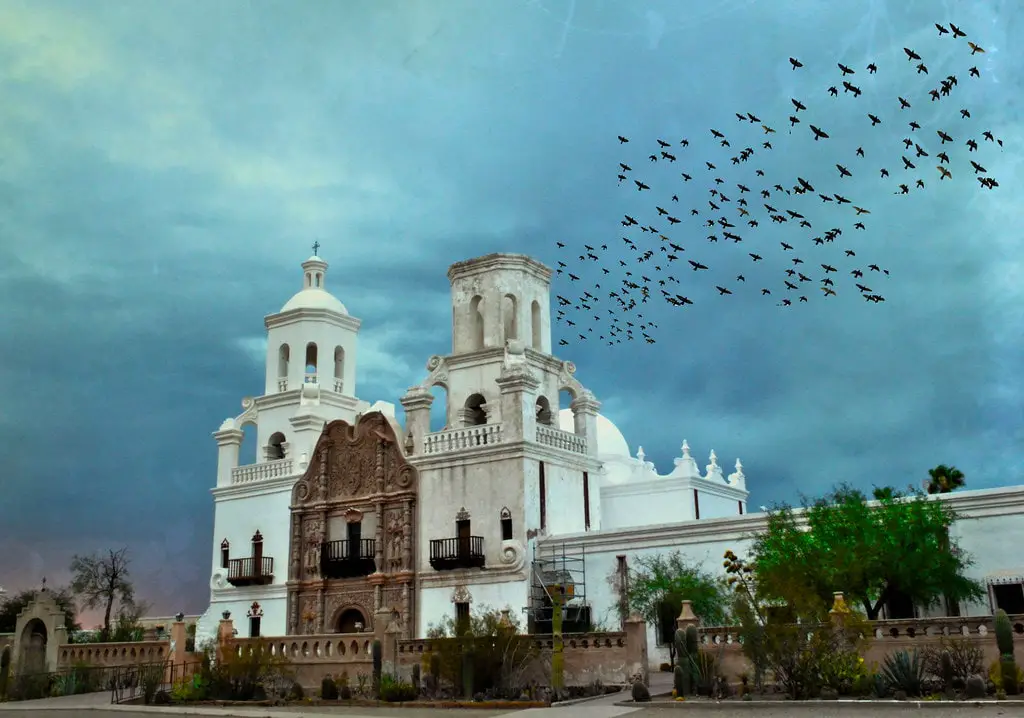Unraveling the Threads of History
Situated approximately 10 miles south of the bustling downtown of Tucson, Arizona, the Mission San Xavier del Bac is a historic Spanish Catholic mission that has stood the test of time.
Nestled within the boundaries of the Tohono O’odham Nation San Xavier Indian Reservation, this mission is more than just a religious institution. It is a symbol of resilience, a testament to the enduring spirit of the community, and a beacon of cultural heritage.
The mission’s origins can be traced back to the late 17th century. In 1692, it was founded by Padre Eusebio Kino, a Jesuit missionary known for extensive work in the Pimería Alta, present-day northern Sonora in Mexico, and southern Arizona in the United States.
The mission was christened in honor of Francis Xavier, a pioneering Christian missionary and a co-founder of the Society of Jesus, also known as the Jesuit Order, in Europe.
The original church that served the mission was not the current structure. It was located north of the present Franciscan church and served the mission until 1770. However, it fell victim to an Apache raid, a stark reminder of the tumultuous times that marked the era of its establishment.
The Birth of the Current Structure
The Mission San Xavier del Bac that graces the landscape today is a product of unwavering determination and remarkable craftsmanship. Constructed between 1783 and 1797, it holds the distinction of being the oldest European structure in Arizona.
The labor for the construction was provided by the local community, a testament to the collective spirit that has always been a part of the mission’s history.

The mission’s construction was a monumental task, given the limited resources and technology of the time. Yet, armed with their unwavering faith and determination, the builders left no stone unturned to ensure the mission’s completion.
The result was a structure that has withstood the ravages of time and continues to inspire awe and reverence.
A Testament to Architectural Grandeur
The mission’s architectural style is a harmonious blend of Spanish and indigenous influences, a tangible manifestation of the cultural exchange that marked the era of its construction. The mission is a U.S. National Historic Landmark, recognizing its architectural and historical significance.

The mission’s intricate carvings, ornate frescoes, iconic domes, and towers are a sight. Each architectural element tells a story, each carving a testament to the skill and artistry of its creators.
The mission’s architecture is not just about aesthetics; it’s a narrative of cultural exchange, adaptation, and resilience.
The Mission San Xavier del Bac in Contemporary Times
Today, the mission serves as a parish church and plays a vital role in the local community and the Tohono O’odham Nation.

It is a historical monument and a living testament to the people’s faith and community spirit. The mission’s cultural and historical significance continues to inspire and educate visitors, making it a cherished landmark.
The mission is a hub of religious and cultural activities. It hosts regular mass services, weddings, and other religious ceremonies. It also serves as a venue for cultural events and educational programs, ensuring the mission remains vibrant and integral to the community.
The Journey of Preservation
Preserving a structure as old and significant as the Mission San Xavier del Bac is monumental. Over the years, various renovation efforts have been undertaken to protect the mission.

These efforts have involved meticulous planning, expert craftsmanship, and a deep understanding of the mission’s historical and architectural significance.
While challenging, these renovation efforts have maintained the mission’s original charm while ensuring its stability and longevity. The impact of these efforts is evident in the mission’s well-preserved facade and interiors, allowing future generations to appreciate this historical gem.
In Conclusion
Mission San Xavier del Bac’s enduring legacy is a testament to Tucson, Arizona’s rich history and cultural heritage. As the oldest European structure in Arizona, the mission stands as a symbol of resilience, faith, and community spirit.

The ongoing efforts to preserve and restore the mission ensure that this historical, cultural, and religious landmark continues to inspire and educate future generations.
